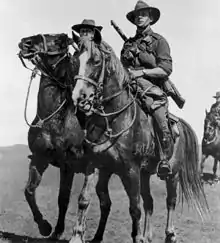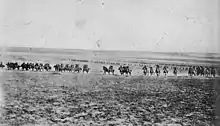Australian Light Horse
Australian Light Horse were mounted troops similar to both cavalry and mounted infantry. They fought in the Second Boer War and World War I.

South Australian Mounted Rifles training in Adelaide, prior to deployment to South Africa, circa 1900.

Australian light horsemen on Walers in 1914, prior to their departure from Australia to serve in World War I.
By the outbreak of World War I, there were 23 light horse regiments within Australia's part-time military force, consisting of 9,000 personnel.[1] These were organised as follows:[2][3]
World War I
Formation and organisation

Australian light horse monument in Beersheeba
Light horse were like mounted infantry. They usually fought on foot. They used their horses as transport to the battlefield. A famous exception to this rule though was the charge of the 4th and 12th Light Horse Regiments at Beersheba on 31 October 1917. In 1918, some light horse regiments were equipped with sabres,[4] so they could fight in a conventional cavalry role in the attack on Damascus. [4]

Troopers of the 4th Light Horse Brigade at Beersheeba, 1917


The winner of the 10th Light Horse Regiment's "Best turned out light horseman" competition at the unit's annual sports day in 1943

95th anniversary parade, 2012
Popular culture
Literature
- The Wells of Beersheba (1933) by Frank Dalby Davison
- The Desert Column (1932) by Ion L. Idriess: the only known published account by a participant who was not an officer.
- As if He Knows (2001) – song by Eric Bogle[5]
References
Citations
- Dennis et al 1995, p. 350.
- Hall 1968, pp. 70–71.
- Australian Military Forces 1914, pp. 10–34.
- Bou 2010a, p. 14.
- "Dorothy Brooke's letter to the Morning Post | Brooke". www.thebrooke.org. Retrieved 16 November 2016.
- Chris (26 December 1940). "40,000 Horsemen (1940)". IMDb. Retrieved 14 August 2015.
- zeppo-2 (26 October 1999). "The Adventures of Young Indiana Jones: Daredevils of the Desert (Video 1999)". IMDb. Retrieved 14 August 2015.
{{cite web}}: CS1 maint: numeric names: authors list (link)
Notes
- Australian Military Forces (1914). Staff and Regimental Lists of the Australian Military Forces, 1st January 1914. Melbourne, Victoria: Government Printer. OCLC 681165642.
- Blenkinsop, Layton John; Rainey, John Wakefield, eds. (1925). History of the Great War Based on Official Documents Veterinary Services. London: HMSO. OCLC 460717714.
- Bou, Jean (2010a). Australia's Palestine Campaign. Australian Army Campaign Series # 7. Canberra, Australian Capital Territory: Army History Unit. ISBN 978-0-9808100-0-4.
- Bou, Jean (2010b). Light Horse: A History of Australia's Mounted Arm. Port Melbourne, Victoria: Cambridge University Press. ISBN 9780521197083.
- Dennis, Peter; et al. (1995). The Oxford Companion to Australian Military History (1st ed.). Melbourne, Victoria: Oxford University Press Australia & New Zealand. ISBN 0-19-553227-9.
- Finlayson, David (2012). Green Fields Beyond. Canberra, Australian Capital Territory: Department of Veterans' Affairs. OCLC 799180097.
- Grey, Jeffrey (2008). A Military History of Australia (3rd ed.). Melbourne, Victoria: Cambridge University Press. ISBN 978-0-521-69791-0.
- Hall, Richard John (1968). The Australian Light Horse. Blackburn, Victoria: W.D. Joynt & Co. OCLC 59504.
More reading
- Bou, Jean (2007). "Cavalry, Firepower, and Swords: The Australian Light Horse and the Tactical Lessons of Cavalry Operations in Palestine, 1916–1918". The Journal of Military History. 71 (1). Lexington, Virginia: Society for Military History: 99–125. doi:10.1353/jmh.2007.0009. hdl:1885/30058. ISSN 0899-3718. S2CID 159813243.
- Mitchell, Elyne (1982). Light Horse: The Story of Australia's Mounted Troops. Melbourne: Macmillan. ISBN 0-7251-0389-2.
- Morrison, James (2006). Mechanising An Army: Mechanisation Policy and the Conversion of Light Horse, 1920–1940 (PDF). Land Warfare Studies Centre Study Papers. Vol. Study Paper No. 307. Duntroon, Australian Capital Territory: Land Warfare Studies Centre. ISSN 1442-8547. Archived from the original (PDF) on 7 March 2016.
- Perry, Roland (2009). The Australian Light Horse. Hachette Australia. Sydney. ISBN 978-0-7336-2272-4.
{{cite book}}: CS1 maint: location missing publisher (link)
This article is issued from Wikipedia. The text is licensed under Creative Commons - Attribution - Sharealike. Additional terms may apply for the media files.